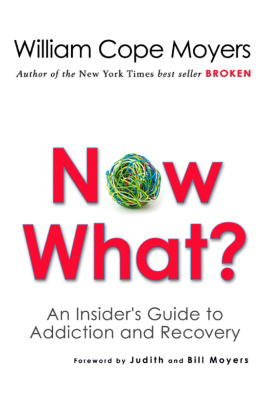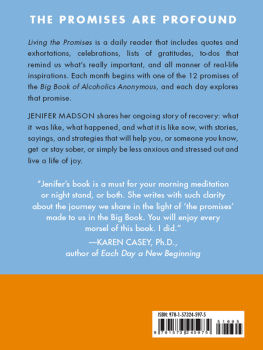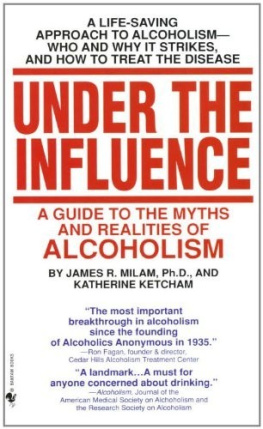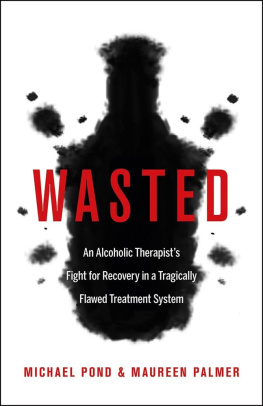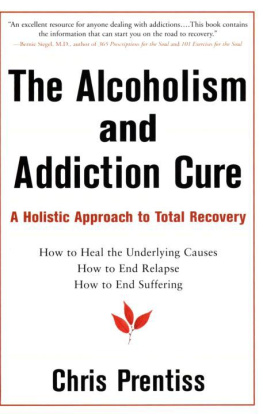ILL QUIT TOMORROW : A Practical Guide to Alcoholism Treatment. Revised Edition . Copyright 1980 by Vernon E. Johnson. All rights reserved under International and Pan-American Copyright Conventions. By payment of the required fees, you have been granted the non-exclusive, non-transferable right to access and read the text of this ebook on-screen. No part of this text may be reproduced, transmitted, down-loaded, decompiled, reverse engineered, or stored in or introduced into any information storage and retrieval system, in any form or by any means, whether electronic or mechanical, now known or hereinafter invented, without the express written permission of HarperCollins ebooks.
FIRST HARPER & ROW PAPERBACK EDITION PUBLISHED IN 1990.
Johnson, Vernon E.
ILL QUIT TOMORROW.
1. Alcoholism. 2. AlcoholismTreatment.
3. AlcoholicsRehabilitation. I. Title.
Mark Twain is reported to have originated the observation Adam had all the best of it. When he said something he knew no one had ever said it before! One has to wonder if Twain really thought of that first. In any case, it is an apt phrase to describe the quandary of this writer in making acknowledgments regarding sources and resources for the thoughts on the following pages. No claim to originality can be made. Nor is it made. One only wishes one could remember each source. Proper credit would gladly and gratefully be made.
From unnumbered sick individuals, Alcoholics Anonymous members, physicians, clergymen, other professionals, has come information and insight. This effort has been simply to synthesize and give order to their contributions.
Three special groups must be given my thanks: first, the hospitals, their patients, their forward-looking boards, and administrative and medical staffs (pioneers in spirit, every one of them); second, the people at Hazelden, Center City, Minnesota, under the guidance of Dr. Dan Anderson, and third, those of the board of the Johnson Institute itself. May they live long on the land and prosper!
Over the years, associates in the work have been manyover two hundred, in fact. If mentioned by name surely I will overlook some. I know they will understand if I say to them simply, Thank you. I feel much more like I do now than I did when we started!
Nevertheless, individual thanks must go to Barbara Heines, secretary, confidante, and friend, whose struggles through hen scratches brought it all to the publisher.
Finally, there is Mary Ann, whose long suffering permitted absences frequently, tardiness often, and whose compassion still answers the constantly jangling home telephone with patience with patients. This book is dedicated to the most normal person I knowmy wife.
Alcoholism is a fatal disease, 100 percent fatal. Nobody survives alcoholism that remains unchecked. We estimate that 10 percent of the drinkers in America will become alcoholic, and that these people will not be able to stop drinking by themselves. It is a myth that alcoholics have some spontaneous insight and then seek treatment. Victims of this disease do not submit to treatment out of spontaneous insighttypically, in our experience, they come to their recognition scenes through a buildup of crises that crash through their almost impenetrable defense systems. They are forced to seek help; and when they dont, they perish miserably.
This disease involves the whole person: physically, mentally, psychologically, and spiritually. The most significant characteristics of the disease are that it is primary, progressive, chronic, and fatal. But it can be arrested. The progress of alcoholism can be stopped, and the patient can be recovered. Not cured, but recovered. This is a hard-headed, pragmatic statement of fact which has visible proof in the recovery of thousands of alcoholics who are well today. They are alive, and they bring alive hope for countless others. Their return gives the lie to the notion that this illness is too complex and too individual by nature even to tackle.
At the Johnson Institute in Minneapolis, Minnesota, we have had the privilege of assisting in the development of more than three dozen such treatment programs in hospitals located in states across the land. The oldest was opened December 1968 at St. Marys Hospital in Minneapolis, where a 112-bed inpatient unit is now available for the treatment of this disease. (In 1975 an outpatient service was added, following the introduction of a fifty-three-bed inpatient unit for adolescents a year earlier.) The programs in these hospitals have recovered thousands who were desperately sick. These people have returned to happy and productive livesnot the bleak, unrewarding, abstinent existence that is associated with arrested alcoholism.
Very simply, the treatment involves a therapy designed to bring the patient back to reality. The course of treatment consists of an average of four weeks of intensive inpatient care of the acute symptoms in the hospital, and up to two years of aftercare as an outpatient.
Annual studies of St. Marys former patients have consistently indicated that 62 percent of the patients never drink again after completing the program. The other 38 percent relapse and experiment with alcohol. About half of these dropouts return and complete the aftercare program successfully, and remain abstinent. This means that in the end, more than three out of four of St. Marys patients successfully recover from alcoholism. Continuing studies of the patients at the other hospitals have indicated almost exactly parallel results.
The myths and old wives tales around alcoholism are legion. When you demythologize it, you find that this disease is an entity as distinct as measles. Alcoholism has a describable, predictable pattern of pathology. It is primary in the sense that it effectively blocks any care or treatment we might want to deliver to any other medical or emotional problem; if an alcoholic has a diseased liver (which, in the later stages, is quite frequent), the doctor cannot do anything about the liver until the alcoholism is brought under control. Our observation of the illness leads us to believe that it is always progressive. It never plateaus. It always worsens.
Who contracts this illness? What sort of personality becomes alcoholic? The answer seems to be that, mysteriously, all sorts of personalities become alcoholic. The fact is that the cause of alcoholism is unknown. The difficult question, in fact, is why some people cannot become alcoholic no matter how hard they try. You must be able to develop a tolerance for ethyl alcohol in order to make it. If alcohol makes you sick and you throw up, you are immune. Drinking is not enoughyou have to get drunk to become alcoholic, but even the definition of drunkenness can cause endless debate.



